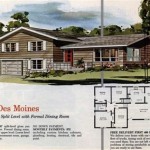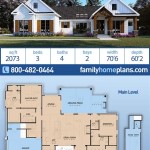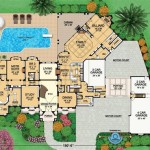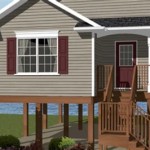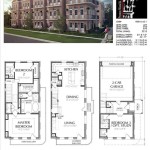Design Your Own House Floor Plans: A Comprehensive Guide
Creating a home is a significant undertaking, and a crucial first step is designing the floor plan. This process allows for a personalized living space tailored to individual needs and preferences. Rather than relying on pre-existing templates, designing your own house floor plans grants complete control over the layout, functionality, and organization of the home. This article provides a comprehensive overview of the key aspects involved in designing your own house floor plans, offering insight into the considerations, tools, and techniques necessary to achieve a successful outcome.
Understanding Your Needs and Lifestyle
Before even considering dimensions and room arrangements, a thorough assessment of needs and lifestyle is essential. This involves identifying the current and anticipated future requirements of the household. Critical questions to consider include: How many occupants will reside in the home? What are their individual needs, such as dedicated workspaces or accessibility requirements? What are the lifestyle habits of the occupants, such as frequent entertaining or a preference for outdoor living?
Further consideration should be given to the type of activities that will occur within the home. Are there specific hobbies or professions that require dedicated spaces? For instance, an artist may need a studio, while a musician may require a soundproofed room. The frequency of entertaining guests should also be factored in, as this will influence the size and layout of living and dining areas. Similarly, the need for storage space should be assessed based on the occupants’ belongings and lifestyle.
Accessibility considerations are paramount, especially for individuals with mobility impairments or anticipated aging in place. This may involve incorporating wider doorways, ramps, and accessible bathroom features. Furthermore, energy efficiency should be a key consideration from the outset. Designing a home with appropriate insulation, window placement, and orientation can significantly reduce energy consumption and utility costs.
Finally, it is vital to establish a realistic budget for the project. Designing a custom house floor plan can be a significant investment, and careful planning is necessary to ensure that the design aligns with financial constraints. Consulting with architects and builders early in the process can provide valuable insights into cost estimations and potential cost-saving measures.
Exploring Design Principles and Layout Considerations
Once the needs and lifestyle have been thoroughly assessed, the next step involves exploring fundamental design principles and layout considerations. This includes understanding spatial relationships, circulation patterns, and the overall flow of the house. A well-designed floor plan should optimize functionality, comfort, and aesthetics.
Zoning is a critical aspect of floor plan design. This involves grouping related spaces together to create distinct functional zones. For instance, the sleeping zone typically includes bedrooms and bathrooms, while the living zone encompasses living rooms, dining areas, and kitchens. Separating these zones can enhance privacy and reduce noise levels. The service zone, which includes laundry rooms, garages, and storage areas, should be accessible but ideally separated from the main living areas.
Circulation refers to the movement of people through the house. A well-designed floor plan should facilitate smooth and efficient circulation, minimizing unnecessary hallways and bottlenecks. Consider the typical routes that occupants will take and ensure that these pathways are clear and unobstructed. Circulation should also take into account the movement of furniture and large items.
Spatial relationships between rooms are crucial for creating a cohesive and functional living space. The kitchen, for example, should be conveniently located near the dining area and potentially have direct access to outdoor spaces for grilling or entertaining. Bedrooms should be situated away from noise-generating areas, such as the living room and kitchen. The size and proportions of rooms should be carefully considered to ensure they are appropriate for their intended use.
Natural light and ventilation are essential elements of a comfortable and healthy home. Optimizing the placement of windows and doors can maximize natural light penetration and promote cross-ventilation. Consider the orientation of the house and the sun's path throughout the day to determine the optimal window placement for each room. Skylights can also be used to bring natural light into areas that may not have access to exterior walls.
In addition to these basic principles, the overall style and aesthetic of the house should also be considered. The floor plan should complement the architectural style and reflect the occupants’ personal preferences. Whether the house is intended to be traditional, modern, or contemporary, the floor plan should be consistent with the overall design vision.
Utilizing Tools and Resources for Floor Plan Creation
Creating a house floor plan can be accomplished using a variety of tools and resources, ranging from traditional methods to modern software applications. The choice of tool depends on the individual's skill level, budget, and desired level of detail.
Traditional methods involve using paper, pencils, and drafting tools. This approach allows for a hands-on experience and can be particularly useful for sketching out initial ideas and conceptual designs. Drafting tools, such as rulers, triangles, and compasses, can be used to create accurate and precise drawings. However, this method can be time-consuming and requires a certain level of technical skill.
Computer-Aided Design (CAD) software offers a more advanced approach to floor plan creation. CAD programs allow for precise and detailed drawings to be created electronically. These programs offer a wide range of features, including the ability to create 3D models, generate construction documents, and collaborate with other professionals. Popular CAD programs include AutoCAD, Revit, and ArchiCAD. While CAD software can be powerful, it typically requires specialized training and can be expensive.
Floor plan software provides a more user-friendly alternative to CAD programs. These programs are specifically designed for creating house floor plans and typically offer intuitive interfaces and pre-designed templates. Floor plan software often includes features such as drag-and-drop functionality, automatic dimensioning, and 3D visualization. Many floor plan software options are available, ranging from free online tools to subscription-based programs. Examples include RoomSketcher, Planner 5D, and SmartDraw. These software programs typically have a shorter learning curve compared to CAD and are often more affordable.
Whether using traditional or digital tools, it is helpful to gather inspiration from existing floor plans. Online resources, such as architectural websites and home design magazines, can provide a wealth of ideas and inspiration. Visiting model homes and attending open houses can also offer valuable insights into different layout options and design trends.
Furthermore, engaging with professionals, such as architects and interior designers, can provide expert guidance and support. Architects can help to translate the occupants’ needs and desires into a functional and aesthetically pleasing floor plan, while interior designers can assist with space planning and material selections. While hiring professionals involves additional costs, the expertise and experience they bring to the project can be invaluable.
Addressing Technical Considerations and Building Codes
Designing a house floor plan is not solely about aesthetics and functionality; it is also essential to address technical considerations and ensure compliance with building codes. These regulations are in place to protect the health, safety, and welfare of the occupants and the community.
Structural considerations are paramount. The floor plan should be designed to ensure the structural integrity of the house. This involves considering the load-bearing capacity of walls, floors, and roofs. Consulting with a structural engineer is crucial to ensure that the design meets all applicable structural requirements.
Plumbing, electrical, and HVAC systems must be integrated into the floor plan. The placement of plumbing fixtures, electrical outlets, and HVAC vents should be carefully planned to ensure they are accessible and functional. Codes dictate minimum requirements for these elements and should be adhered to. It is usually beneficial to consult with qualified professionals, such as plumbers, electricians, and HVAC technicians, to ensure that these systems are properly designed and installed.
Fire safety is another critical consideration. The floor plan should include adequate fire exits and smoke detectors. Codes often specify minimum distances between exits and the required number and placement of smoke detectors. Fire-resistant materials may also be required in certain areas of the house. Local fire departments can provide guidance on fire safety regulations.
Energy efficiency is an increasingly important aspect of building codes. Many jurisdictions have adopted energy codes that specify minimum requirements for insulation, window performance, and HVAC system efficiency. Designing a house floor plan that incorporates energy-efficient features can help to reduce energy consumption and lower utility costs. Orienting the house to maximize solar gain can reduce winter heating costs, while shading strategies can minimize summer cooling costs.
Accessibility regulations are also becoming more prevalent. These regulations require that new homes be designed to be accessible to people with disabilities. This may involve incorporating features such as wider doorways, ramps, and accessible bathrooms. The Americans with Disabilities Act (ADA) provides detailed guidelines for accessibility in public accommodations and commercial facilities, and these guidelines can also be used as a resource for residential design.
Navigating building codes can be complex and time-consuming. Working with experienced architects and contractors who are familiar with local building codes can help to ensure that the design complies with all applicable regulations. Obtaining the necessary permits before starting construction is essential, as failure to do so can result in costly delays and fines.

House Plans How To Design Your Home Plan

House Plans How To Design Your Home Plan

Design Your Own Home House Designing Homes

House Plans How To Design Your Home Plan

Creating Your Dream Custom Floor Plan Citadel Signature Homes

Choosing The Best Floor Plan For Your Modular Home Next

Floor Plans Learn How To Design And Plan

From Sketch To Reality How Design A House You Ll Love

Custom Home Designs Design Your Dream Pulte

Customize Your Floor Plan Diyanni Homes

